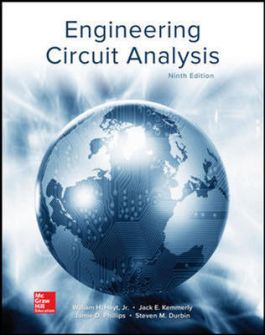EBOOK Engineering Circuit Analysis 9e
- Note: the eBook does not include access to Connect
- Access the eBook anytime, anywhere: online or offline
- Create notes, flashcards and make annotations while you study
- Full searchable content: quickly find the answers you are looking for
Chapter 2 Basic Components and Electric Circuits
Chapter 3 Voltage and Current Laws
Chapter 4 Basic Nodal and Mesh Analysis
Chapter 5 Handy Circuit Analysis Techniques
Chapter 6 The Operational Amplifier
Chapter 7 Capacitors and Inductors
Chapter 8 Basic RC and RL Circuits
Chapter 9 The RLC Circuit
Chapter 10 Sinusoidal Steady-State Analysis
Chapter 11 AC Circuit Power Analysis
Chapter 12 Polyphase Circuits
Chapter 13 Magnetically Coupled Circuits
Chapter 14 Circuit Analysis in the s-Domain
Chapter 15 Frequency Response
Chapter 16 Two-Port Networks
Chapter 17 Fourier Circuit Analysis
Appendix 1 An Introduction to Network Topology
Appendix 2 Solution of Simultaneous Equations
Appendix 3 A Proof of Thevenin's Theorem
Appendix 4 An LTspice Tutorial
Appendix 5 Complex Numbers
Appendix 6 A Brief MATLAB Tutorial
Appendix 7 Additional Laplace Transform Theorems
Appendix 8 The Complex Frequency Plane
The hallmark feature of this classic text is its focus on the student - it is written so that students may teach the science of circuit analysis to themselves. Terms are clearly defined when they are introduced basic material appears toward the beginning of each chapter and is explained carefully and in detail and numerical examples are used to introduce and suggest general results. Simple practice problems appear throughout each chapter while more difficult problems appear at the end of chapters following the order of presentation of text material. This introduction and resulting repetition provide an important boost to the learning process. Hayt's rich pedagogy supports and encourages the student throughout by offering tips and warnings using design to highlight key material and providing lots of opportunities for hands-on learning. The thorough exposition of topics is delivered in an informal way that underscores the authors' conviction that circuit analysis can and should be fun.

